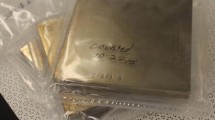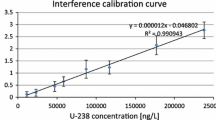Abstract
An inductively coupled plasma atomic emission spectroscopy method for speciation of Ag, Cu, Bi, Sb, As, Ni, Cd, Zn, Sn, and Fe in grade lead is described. The spectrometer was calibrated using water solutions with known concentrations of trace elements. The matrix effects were taken into account using an internal standard added to the reference-sample, calibrated-blank, reagent-blank, and tested-sample solutions. The metrological examination of the technique was accomplished. The repeatability rms error does not exceed 0.10. The systematic error is not statistically significant.
Similar content being viewed by others
References
Kuur, R.S. and Eremeeva, O.V., Analiz novykh tendentsiy na mirovom rynke produktsii svintsovo-tsinkovoy promyshlennosti v usloviyakh globalizatsii mirovogo khozyaistva (Analysis of New Trends in the World Lead-Zinc Industry Market under Conditions of World Economics Globalization), Ust’-Kamenogorsk: DTP “VNIITsvetmet,” 2005.
GOST (State Standard) 3778-98. Lead. “Technical conditions”, Moscow: Izd. Standartov, 1978.
GOST (State Standard) 8857-77. Lead. Method of Spectral Analysis, Moscow: Izd. Standartov, 1983.
Vysokochastotny inductivno-svyazanny plazmenny razryad v emissionnom spectral’nom analize: Sbornik nauchnykh trudov (RF Inductively Coupled Plasma Discharge in Emission Spectral Analysis: Collection of Papers), Zilbershtein, Kh.I., Ed., Leningrad: Nauka, 1987.
Thompson, M. and Walsh, J.N., Handbook of Inductively-Coupled Plasma Spectrometry, London: Chapman and Hall, 1983.
Chudinov, E.G., Inductively Coupled Plasma Atomic Emission Analysis, Itogi Nauki Tekh. Ser. Analit. Khim., vol. 2, Moscow: VINITI, 1990.
Boss, C. B. and Fredeen, K. J., Concepts, Instrumentation and Techniques in Inductively Coupled Plasma Optical Emission Spectrometry, 2nd ed., Perkin-Elmer Corp., Norwalk: 1999.
Pupyshev, A.A. and Danilova, D.A., Atomno-emissionny analiz s induktivno svyazannoi plazmoi i tleyushchim razryadom po Grimmu (Grimm Glow-Discharge Inductively Coupled Plasma Atomic Emission Analysis), Yekaterinburg: GOU VPO UGTU-UPI, 2002.
RMG (Recommendations on Interstate Standardization) 61-2003. Indices of Accuracy, Validity, and Precision of Methods for Quantitative Chemical Analysis. Methods for Evaluation, Moscow: Izd. Standartov, 2004.
Author information
Authors and Affiliations
Additional information
Original Russian Text © N. G. Pelevina, 2008, published in Zavodskaya Laboratoriya. Diagnostika materialov, 2008, Vol. 44, No. 14, pp. 12–16.
Rights and permissions
About this article
Cite this article
Pelevina, N.G. Use of plasma atomic emission spectrometry for the quality control of grade lead. Inorg Mater 44, 1554–1558 (2008). https://doi.org/10.1134/S0020168508140112
Received:
Published:
Issue Date:
DOI: https://doi.org/10.1134/S0020168508140112




